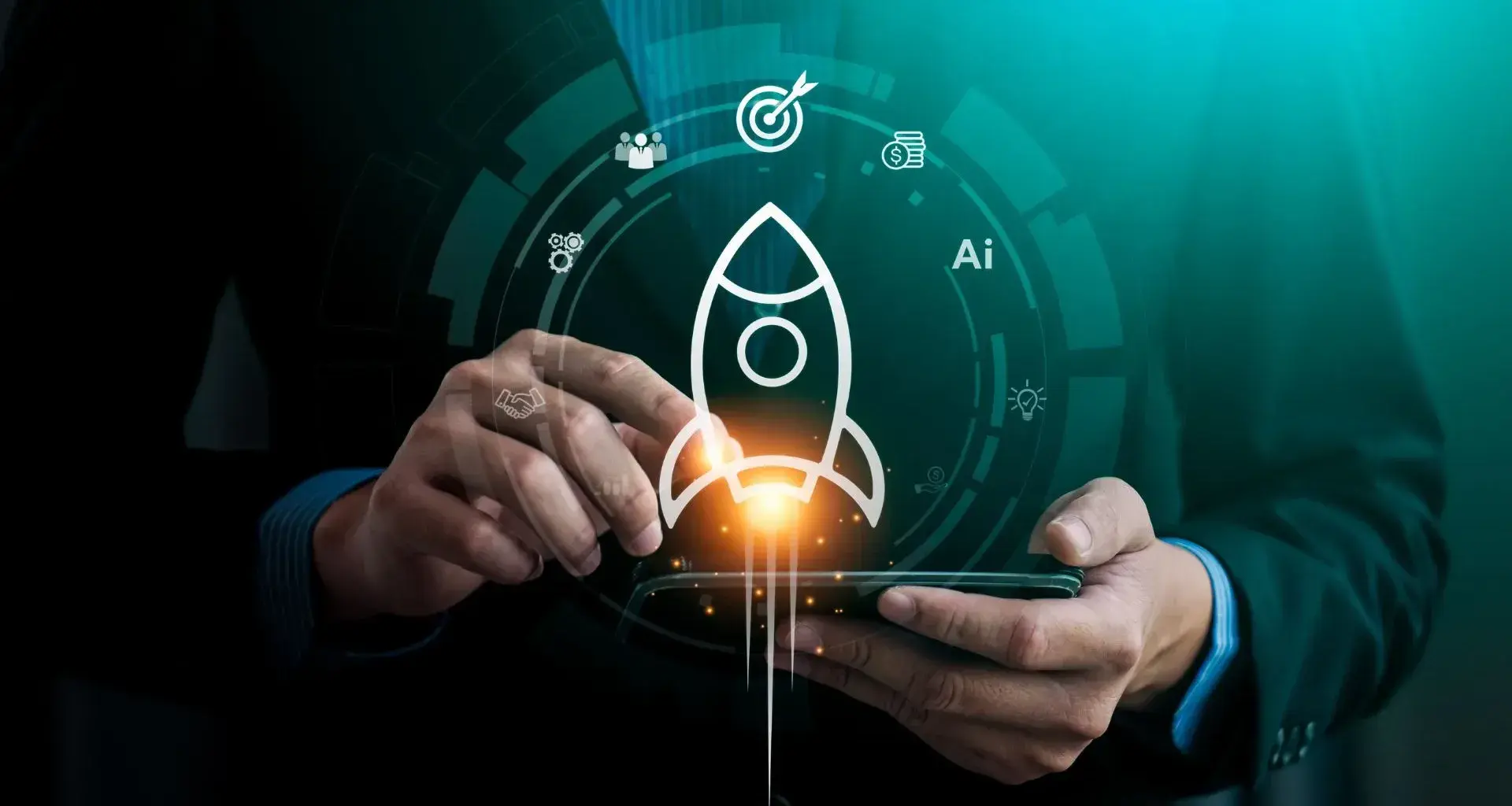Initiatives that seek to solve health, education, environmental, and industry issues, all distinguished by their use of science and technology, have been presented to investors and companies.
OVer 20 innovation projects participated in the second edition of EBCTec Spin-offs DemoDay & Industry Challenges at Tecnológico de Monterrey.
“It’s very important to commit to bringing science to the market and to solving problems that exist in Mexicoand the world,” said Mario Adrián Flores, Vice President of the Tec’s Monterrey Region.
The Directorate of Technology Transfer and Science and Technology-Based Entrepreneurship organized the event to foster valuable connections between innovation ecosystem stakeholders involved in research, as well as to help scale these ventures.
Initiatives were presented on food production, tissue production, 3D-printed prostheses and organs, synthetic microbiota, education platforms, smart mobility solutions, and systems designed to enhance industrial operations, among other technology-based proposals.

The Tec’s Directorate of Technology Transfer and Science and Technology-Based Entrepreneurship is responsible for managing inventions generated by talent associated with the institution itself.
Its responsibilities include:
- Fostering the creation and generation of open calls for the scaling up and acceleration of the Tec’s innovation projects
- Creating and developing science and technology-based ventures
- Connecting the institution’s talent and projects with national and international innovation and entrepreneurial ecosystems
- Attracting investment funds for the scaling up and acceleration of innovation projects
- Ensuring commercialization and technology transfer through licensing and development of startups
The initiatives presented during EBCTec 2025 Spin-offs DemoDay & Industry Challenges are at different stages of development and are looking to scale their projects. These include Forma Foods, GNA, and EduMeds.
Here are some of those initiatives:
Technology dedicated to advancing healthcare
1. Medditiva: 3D materials designed for medical uses
Héctor Aguirre from Medditiva explained that while 96% of physicians believe that using 3D models (for organs and other medical uses) enhances patient outcomes, only 20% actually use them.
“3D printing technology generates accurate organ replicas at a very low cost.
“In addition, it employs unique materials on the market that not only replicate the characteristics of tissues but also make it possible to observe internal reactions due to their transparency.”
Medditiva has spent the past six years studying the process to optimize and customize prostheses, thus reducing failure rates.
He mentioned the following key points of their initiative:
- Anatomical precision that ensures millimeter-level fidelity to the patient’s body
- The use of innovative materials such as flexible polymers to customize the mechanics and transparency of the model
- Affordable price, at 30% the cost offered by the competition
GeneSIRTBio: for fibrosis-free respiration
2. GeneSIRTBio is developing a gene therapy that, according to its developers, could reverse up to 25% of fibrosis with a single dose.
This solution utilizes the human gene SIRT1, which regulates critical cellular processes such as inflammation and oxidative stress.
The therapy is administered via viral vectors or nanoparticles in aerosol form directly to the lungs.
This approach makes it possible to attack the problem at its root rather than merely halting it temporarily. The proposal integrates genomic medicine with a translational clinical approach.
They are currently concluding the preclinical stage.
3. MikMed: Medical implants and simulators
Raquel Tejeda of MikMed stated that cardiovascular diseases are the leading cause of death worldwide, with an incidence that has increased by 31% over the past 20 years.
“Cardiovascular diseases are the leading cause of death, accounting for 17.8 million deaths worldwide.”
Through customized materials and designs, MikMed creates 3D-printed medical implants and simulators that, according to Tejeda, are transforming the way cardiovascular diseases are treated.
“The devices we design with the materials we use are customizable, from the design and construction of the devices themselves to the cardiovascular implants.”
As key points, the speaker noted better patient navigability due to its customized design and high durability, with a lifespan of 20 years, thereby reducing the need for repeated interventions.
4. Ocular Bio Design: Bioengineering dedicated to enhancing vision
This spin-off began as a tissue engineering company aimed at restoring vision by creating functional, biosynthetic, and biocompatible tissues.
According to its founder, Judith Zavala, the process involves obtaining healthy corneal tissue, isolating the cells that do not naturally multiply in the body and cultivating them in a laboratory while preserving their functional characteristics.
“This technology is unique due to its efficiency in increasing the availability of corneal tissue and drastically reducing the cost of transplantation (...)
“We’re highly motivated by the potential to save lives through technologies that outperform conventional methods in one or more ways,” she said.
5. ALIA Health: Imaging solutions for health forecasting
ALIA Health has developed AI-powered technologies that analyze medical images to predict health outcomes and reduce the risk of developing diseases.
Its first product, MammoRisk Plus, predicts the risk of developing breast cancer within the next five years using patented models capable of detecting the threat from the initial mammogram.
The initiative aims to create digital platforms that allow for direct, barrier-free access to this predictive technology, eliminating the need for intermediaries.
Currently, the team is in the formalization and commercial validation phase, collaborating with world-class companies in data processing.
6. Sytosol: For timely detection of diseases
Inspired by the challenge represented by timely cancer detection using tomography, Omar Martínez, Co-founder and President of Sytosol, aims to provide a solution based on electrochemical sensor technology.
As they are highly sensitive and utilize microfabricated materials that only require low-volume samples for diagnosis, these sensors are designed to detect key biomarkers which are critical for disease detection.
“We envision a future in which timely diagnosis of diseases becomes routine, affordable, and available to everyone.
“Timely detection of diseases saves lives. Together, we can make a world in which timely disease detection is both quick and precise,” Martínez said.
7. Enspheres: Transforming genetic medicine
Enspheres is a platform that reimagines gene and cell therapy.
Their Asymmetric Flexible Liposomes, also called AFLs, are nano-capsules designed to act as tailor-made keys.
They enter gently, without causing harm, delivering genetic material precisely where and when it is needed.
Enspheres is currently at an advanced stage of preclinical development. It has achieved successful laboratory validations and currently has a provisional patent pending.
8. GeneSIRTBio: For fibrosis-free breathing
GeneSIRTBio is developing a gene therapy capable of reversing up to 25% of fibrosis with a single dose, according to its developers.
This solution employs the human gene SIRT1, which regulates key cellular processes such as inflammation and oxidative stress.
The therapy is delivered via viral vectors or nanoparticles as an aerosol directly targeting the lungs.
This approach makes it possible to attack the problem at its root rather than merely slowing it down temporarily. The proposal integrates genomic medicine with a translational clinical focus.
They are currently concluding the preclinical stage.
9. Hepacys-N: Liver repair without side effects
Pharma Therapeutics is a biotech spin-off focused on developing treatments for chronic liver diseases by repurposing already approved molecules.
Their product Hepacys-N combines N-acetylcysteine and naringenin. This combination delivers both antifibrotic and antioxidant benefits.
In addition, their combined use enhances therapeutic efficacy, allowing for a more effective intervention in the early stages of the disease.
The treatment utilizes new delivery systems, including nanoparticles and liposomes, to enhance absorption and target the effect directly to the affected organ.
Currently, the team leading the initiative has completed preclinical studies and is preparing to launch clinical trials in partnership with academic and pharmaceutical institutions.
10. Naddon: Enhancing quality of life for those with chronic diseases
Naddon is a nanotechnology-based platformthat encapsulates drugs within intelligent nanoparticles. These particles do not travel randomly throughout the body.
Depending on their design, they detect specific inflammatory signals, such as changes in tissue pH or temperature. They also recognize specific receptors. These health platforms activate only upon reaching the targeted site or in response to the disease condition.
By combining passive and active targeting, this approach ensures the drug acts precisely where needed, minimizing dispersal throughout the body. It proposes more effective therapies with fewer side effects and less invasive treatment for the patient.
This technology is both biocompatible and biodegradable, meaning it leaves no toxic residues and can be incorporated into a broad range of existing drugs.
Nutrition and food for all
11. Forma Foods: Designers of sustainable meat
Aiming to create high-quality, flavorful foods that are also environmentally friendly, Grissel Trujillo of Forma Foods highlighted how their spin-off tackles the challenges associated with meat production.
“The world needs Forma Foods because we need to produce food sustainably and responsibly for both this generation and for future generations.”
According to Trujillo, the project utilizes technology to create plant-based structures that replicate the characteristics of real meat tissues through 3D printing.
In the context of climate change, along with the pressure to produce food on a large scale, sufficiently, and sustainably, Trujillo said that they also found a way to leverage emerging technologies.
The researcher envisioned this spin-off as also contributing to tissue engineering and medical applications, thus being re-purposed for human nutrition.
12. Jaseda: Adding value to endemic foods
Janet Gutiérrez, Co-founder of Jaseda, stated that around 31 million people die from heart disease, diabetes, and cancer worldwide.
Nevertheless, oxidative stress, a key factor in these diseases, can be combated by including supplements in our diet.
“Jaseda aims to enhance global health by harnessing the potential of Mexico’s endemic crops. Products such as Wellbean and Tansanas are already patented and employ various technologies to extract and stabilize valuable bioactive compounds.
“We’re a team closely linked to the industry, dedicated to creating the solutions needed for healthier nutrition and a significantly more sustainable life on our planet.”
This initiative not only focuses on producing patented food products but also on simultaneously enhancing the ability to generate knowledge and develop new products based on science and technology.
13. Jasdan Nutrition: Science-Driven Nutrition
Janet Gutiérrez, professor and Associate Dean of Faculty Development, explained that Jasdan represents a new generation of products featuring two essential ingredients widely considered vital for a healthy diet: healthy fats and proteins.
“This molecule, which we successfully produced from a legume, helps stabilize healthy fats in a finished, functional product that is also highly accessible.
“We offer proteins that can be sourced in a sustainable way. Specifically, we use legumes (...) Additionally, we have a chemical element that, when present in sufficient amounts, supports antioxidant activity.”
Gutiérrez explained that during the germination process, the products (chickpeas) absorb elements that transform them organically, making them highly bioavailable and safe for human consumption.
Innovating education with science
14. EdumedExperts: Patient-centered learning
Silvia Olivares, founding partner and Director of Innovation for this initiative, explained that the project is a platform designed to connect educational institutions with health institutions.
Olivares said that this is achieved through evaluation using the training model known as “patient-centered learning.”
“What sets Edumed Experts apart from other solutions is its focus on a very particular segment of education, healthcare, which is heavily regulated and requires accreditations (...)
“Its contribution lies in reducing that complexity, allowing both hospitals and universities to concentrate exclusively on the academic and clinical care aspects.”
The venture collects and provides real-time performance feedback for both teachers and students through algorithms and an intuitive interface, allowing for instant evaluations that drive continuous improvement with immediate responses.
15. FRED: Education through gamified experiences
The FRED platform allows any university course to be turned into a gamified experience by incorporating game elements into non-game settings to motivate and facilitate the achievement of learning objectives.
According to information presented by the project leaders, missions, achievements, and rewards strengthen self-management and foster collaborative teamwork.
FRED integrates three fundamental axes: curriculum planning, visual progress tracking, and personalized gamification dynamics.
In addition, the system supports peer evaluation, automated feedback, and real-time analysis.
Currently, this project is finalizing its functional web version and is setting up a pilot phase for the August-December 2025 semester.
“It’s very important to commit to bringing science into market solutions and addressing challenges in Mexico and the world.” – Mario Adrián Flores
Research designed to support industry
16. Global NanoAdditives: The new industrial lubricants
Edgar Raygoza, Founder of GNA, mentioned that inadequate industrial lubrication causes mechanical components to lose up to 70% of their functionality.
“What we do at GNA is really to incorporate nanoparticles. These nanoparticles can significantly enhance the lubricating properties of oil.
“They also conduct temperature more efficiently, making them superior coolants and extending the lubricant’s operational lifespan.”
He explained that GNA’s products also seek to reduce carbon dioxide (CO2) emissions and address operational issues such as staining and oxidation of parts, bad odors, and skin irritation among operators.
17. Pibot, robótica en tus manos
17. Pibot: Robotics at your fingertips
Pibot is presented as a brand of robots that can be operated or “driven” like a remote-controlled car, while also having the ability to move autonomously by following commands through a screen interface.
According to Jorge Lozoya during his presentation, a service robot can provide vital support for monitoring, patrolling, and even generating detailed reports to help ensure the safety of individuals.
“We’ve evolvedPibot’s capabilities to include performing inventories, reviewing the environment in terms of occupancy of people and things, and autonomously (teleoperated) patrolling and monitoring of zones.
“Pibot’s ultimate goal goes beyond just creating robots (...) We want to cultivate talent to bring solutions from the lab to businesses, communities, and ultimately, the end users. All of this is made possible by Mexican talent,” Lozoya said.
“Our goal goes beyond just creating robots. We want to cultivate talent to bring solutions from the lab to business, communities, and ultimately, the end users with Mexican talent.” – Jorge Lozoya
18. Arquitectura de Horizontes: Transforming complexities into possibilities
Edgar Barroso, Founder of Arquitectura de Horizontes, aims to combine human and AI systems into hybrid systems or “agent networks” that can help better understand how to solve and transform challenges.
“We conduct a consulting process lasting from 3 to 12 months, working closely with organizations to understand their needs, particularly those related to complex challenges.
“We developed a series of artificial intelligence agents, some fixed ones based on structures from Arquitectura de Horizontes and others that are generative, which are specifically tailored to meet this company’s needs.”
Barroso explained that the project utilizes various models, both quantitative and qualitative techniques, and scientific methods to manage information within fractal networks with the potential for self-replication.
Solutions to protect the environment
19. WheelTech: Intelligent electromobility
Recognizing that daily activities —particularly in the city — consume energy and emit polluting or greenhouse gases, 3J&M identified the transportation sector as one of the largest energy consumers.
José Ignacio Huertas, founder of the project, explained that transitioning to electric vehicles would significantly reduce emissions, particularly greenhouse gases in urban areas.
WheelTech, 3J&M’s product, aims to lower operating and maintenance costs by providing a viable alternative for last-mile deliveries.
“What makes our product unique is that it comes equipped with built-in telemetry. That means it is equipped with sensors that monitor the vehicle’s location, electrical consumption, and the load it is carrying.
“Our business model is based on a wheel that incorporates all the electrical and electronic components. These are all of the necessary additions for converting a light vehicle into an electric one,” he said.
20. BioClean AlgaWater: Transforming waste into microalgae
BioClean AlgaWater transforms polluted water into useful resources using microalgae, operating within a genuine circular economy framework. This project is currently in the technological validation and early commercial development phase.
In this case, the microalgae feed on excess pollutants to grow, requiring noadded nutrients or chemicals, thereby purifying the water naturally.
The process not only reduces pollution but also generates two valuable products: treated water and a nutrient-rich biomass that can be used as biofertilizer.
BioClean AlgaWater offers four services based on this technology: technical consulting on wastewater management, design of customized treatment systems, commercialization of microalgae, and selling biomass for use as fertilizers or nutritional supplements.
21. Hummsky Agrosolutions: More efficient and sustainable crops
AtmosTrace is a modular wireless sensor system. Its central station measures temperature, humidity, CO₂ levels, particulate matter, wind, and other environmental factors.
These sensors are installed at strategic locations within the crop and transmit real-time data via long-range communication to a centralized cloud platform.
The system is fully autonomous and easily adaptable to different scales, from urban gardens to large industrial farms.
Hummsky Agrosolutions is currently in the field validation stage of its AtmosTrace technology, fine-tuning both its prototype and business model to enable scalable implementation.
22. AIoT4All: Internet of Things to protect water resources
In Mexico, 57% of the water used in agricultural irrigation systems is wasted, said Miriam Pérez of AIoT4All, the spin-off that aims to address this issue via sensors adaptable to water, potting soil, and air.
According to Pérez, the project employs parameters to assess the quality of water intended for irrigation, aquaculture waste, or reuse.
“The AIoT4All technology is fully managed by us, from installing the sensor at the point of use to providing comprehensive visualization tailored to the technology’s intended purpose.
“Using an Internet of Things platform, AIoT4All monitors 18 critical variables in real time and presents the data through an intuitive web interface (...) It has now been implemented in various greenhouses, proving its effectiveness in the field.”
Primo Electric Vehicle: Clean mobility accessible to all
23. Primo Electric Vehicle designs electric vehicles featuring a modular design and localized architecture, tailored to the streets and specific needs of Mexico’s urban and industrial settings.
It incorporates an electric drivetrain, power electronics, and agile manufacturing processes, allowing it to adapt to various applications such as cargo, passenger, surveillance, and urban transportation.
Its energy system has been successfully prototyped in the lab, and the full vehicle design is currently in the advanced simulation phase.
Primo Electric Vehicle is currentlyfocused on building a local supply chain and securing strategic partnerships for the first production line.
24. ENVINTECS: Building holistic environmental solutions
As it is estimated that 70% of surface water is polluted, partly by heavy metals, Miguel Ángel López of ENVITECS explained that one of the problems related to this issue is linked to water treatment.
According to López, modern technologies are not implemented in water purification or treatment systems because of the high investment and ongoing operational costs.
“Our technology tackles both of these challenges. On the one hand, it effectively removes heavy metals, and on the other hand, it is affordable.
“It’s a filtration system that employs a membrane or granular material based on a process that delivers innovative, effective, simple, user-friendly technology with low energy consumption.”
In addition, he said that they avoid environmental pollution by recycling the materials they use as construction materials once they reach the end of their lifespan.
Pet health is also important
25. MicroBioMe: dedicated to animal wellbeing
Based on an estimate that over 190 million animals worldwide are used annually for scientific research, Yocán Perfecto, Co-founder of SmartTec BioHealth, proposed a method to help reduce these figures.
According to Perfecto, their project consists of a platform built around three essential components:
- Development of minimal synthetic consortia by identifying the components that most accurately replicate a given condition.
- A low-volume cultivation system equipped with AI-powered software for monitoring
- Integration of collected data to assess whether a compound exerts a beneficial or detrimental impact on the microbiota.
“The minimal synthetic consortia employed by the microBioMe platform are small-scale ecosystems composed of essential bacteria.
“These consortia are chosen to mimic specific intestinal environments, allowing for study the effects of new products on the gut microbiota without requiring animal testing.”
ProForm Dynamic: The next generation of prostheses
26. ProForm Dynamic is a platform for designing, developing, and manufacturing prostheses, orthoses, and bone implants tailored to various species and types of animal injuries.
By utilizing advanced imaging, 3D printing, and medical-grade alloys, it produces anatomically accurate and biocompatible solutions.
The design focuses on small and equine species, but the team foresees its evolution into human applications.
Each device is custom-made locally, which lowers costs and enhances post-sale follow-up.
ProForm Dynamic has initiated the patent registration process for one of its products and continues to advance in the development of its products and services.
LEARN MORE:





